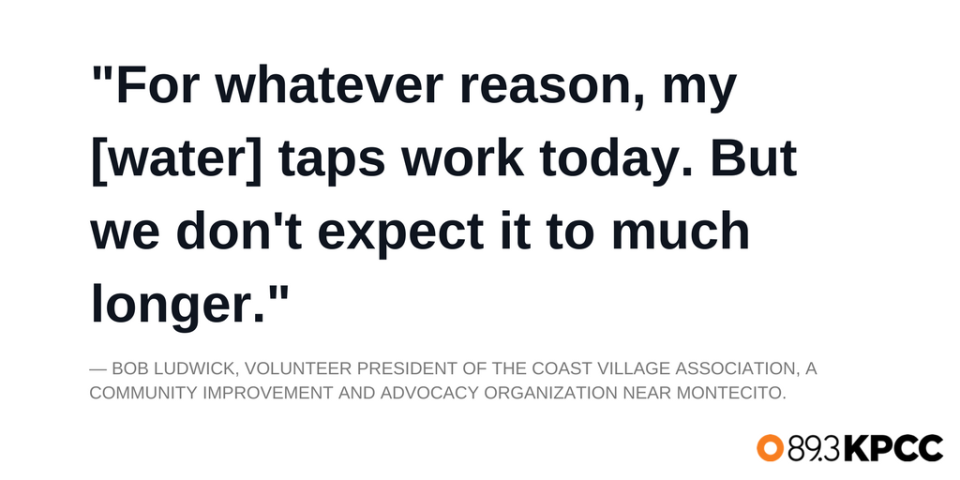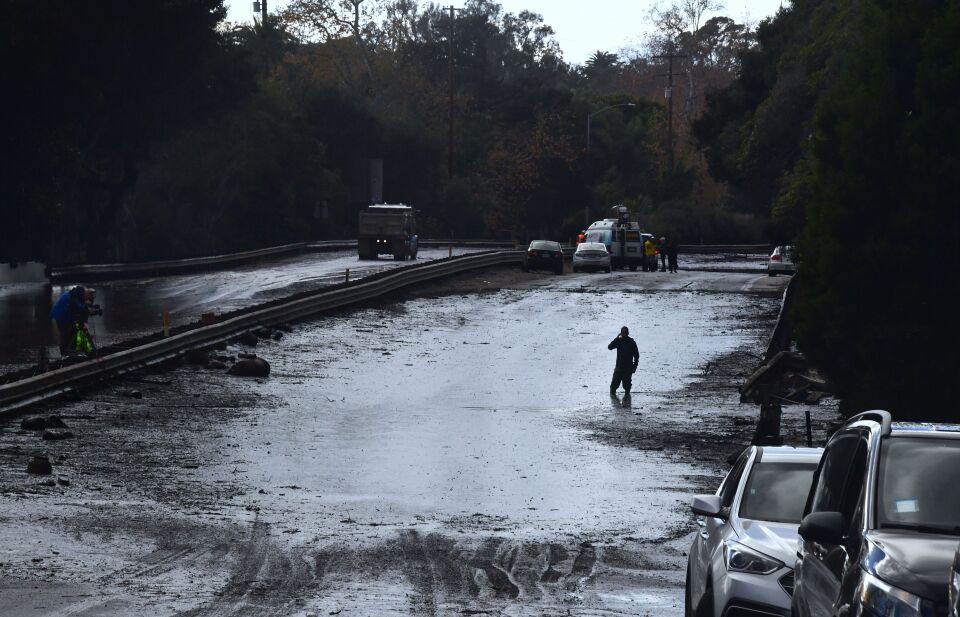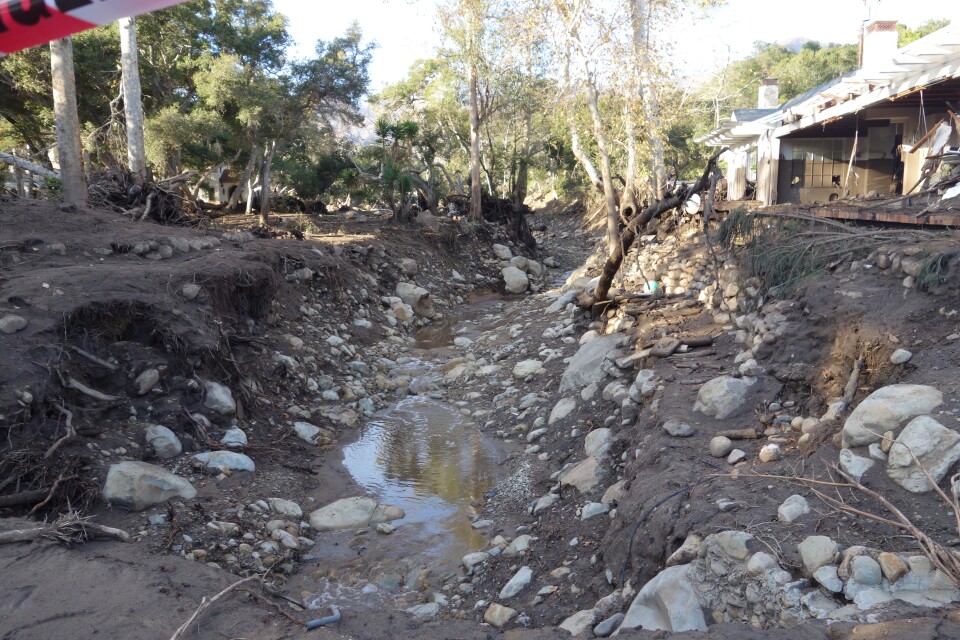The long-term impact of extreme weather on California's infrastructure, Cal Trans on cleaning up after a mudslide, putting the spotlight on L.A. County's 88 cities.
Montecito: A paradise lost after fire and storms
When he first arrived in Montecito in 1970, Bob Ludwick thought he'd found a California paradise.
"It's delightful," Ludwick said of the community. Ludwick has an active hand in the area as the volunteer president of the Coast Village Association, which advocates for the community and its businesses.
For 47 years, Ludwick and his family have enjoyed Montecito for its vistas and atmosphere in the county of Santa Barbara. "It really was a very sleepy well-kept secret."
But things have changed in the last few months. In December, the Thomas fire blazed through the area. And this week, a storm triggered a mudslide that has killed at least 17 people and destroyed local homes and facilities.
"There's nothing like it in the history of Santa Barbara," Ludwick said. "The only thing that's closest is the 1925 earthquake that leveled all of downtown Santa Barbara, which is about four miles away from us."
For Ludwick and his fellow Montecito community members, the back-to-back disasters and the subsequent damage have been a lot to process. Utilities have been all but shut off. Roughly 80 local businesses, most of which represented the livelihood of their owners, have been affected. Every problem seems to lead to another.
"It hasn't stopped," Ludwick said. "I think of it like somebody who's had a serious injury abdominally and, about eight days later, you find out that your spleen ruptured. It takes a long time for the impacts to surface themselves."

Ludwick also has also had to mourn a close personal friend who died in the mudslides.
"He was swept away from an area that was not in the mandatory evacuation zone," Ludwick said. "His home is gone. He, true to form, gave his life trying to save his kids. That is really a sad tragedy for someone I've known my entire adult life. I expect to know a good portion of the people who have perished."
But Ludwick and his neighbors are trying to find the best way to help out those around them. He anticipates that they will come together in this difficult time, but he doesn't expect Montecito to be a paradise again for a long time.
"I think a decade or more will be required to restore Montecito to whatever glory it once had," Ludwick said.
"I'm personally optimistic because that's my nature. But I'm also a realist ... we really aren't going to be able to return to business as normal. I don't see that happening."
What does a changing climate mean for California's infrastructure?
The recent fires and rains in Southern California have led to mudslides, debris flows and rock falls along the Santa Barbara County coast. At least 17 people have died, dozens of homes have been destroyed and, in the coastal village of Montecito, the water system was severely damaged.
With extreme weather becoming the norm in California, Take Two reached out to Stanford University earth science professor, Noah Diffenbaugh, to learn more about the state's infrastructure and its level of preparedness for natural disasters.

Why is the weather becoming more intense?
The United States is seeing more extreme weather events due to climate change -- including heavy precipitation, large storms and drought conditions, Diffenbaugh says.
"The one degree Celsius of global warming that's already happened is already increasing the frequency, and in some cases severity, of [weather] extremes."
Diffenbaugh says this change also applies to California specifically.
"We're seeing increasingly, whether it's the Oroville crisis in 2017 or these recent wildfires, that we're getting combinations of events that were less likely earlier in California's climate history."
What does this new norm mean for our infrastructure?
Diffenbaugh says California's infrastructure may not be able to handle our new climate reality because it was designed and built when extreme weather patterns were not a factor.
"In California, our water resource infrastructure, for example, that was mostly designed and built 50 or even 100 years ago, and what we are seeing with climate change is that increasingly the climate that existed when that infrastructure was designed and built is outdated."
The new climate cycle here in California goes something like this:
- A larger fraction of precipitation is now falling as rain, not snow.
- This means that during the rainy season, dams and reservoirs fill up sooner and water has to be released to prepare for potential flood control.
- The snow we do get is melting faster, which means that when the dry season comes, there's a lack of snow pack and less of a water supply during that pivotal time.
What can California do?
Diffenbaugh is part of a state Climate-Safe Infrastructure Working Group formed in 2017 to help integrate climate change data into future infrastructure projects.
"California is showing tremendous leadership in integrating our best understanding of climate change into infrastructure decisions."
Diffenbaugh said the state is setting a good example of how to consider our changing climate when we invest in infrastructure.
Highway 101 won't reopen until Monday as Caltrans continues clean up from mudslides
This week's rainstorm continues to wreak havoc in the Montecito area. Seventeen people have died and eight people are still missing. Dozens of homes have been destroyed and hundreds more have been damaged in Santa Barbara County.
The mud is waist high along a 13-mile stretch of Highway 101 between Ventura and Santa Barbara that's been closed since Tuesday. Officials with the California Department of Transportation say the earliest it will reopen is Monday.
That stretch of the 101 is among the only points of access to communities affected by the mudslides. With many local roads also impassable, residents are hard pressed to meet basic daily needs — like picking up prescriptions or getting groceries.
Susana Cruz is a public information officer with the California Department of Transportation. She joined Take Two's A Martinez to talk about the 101 cleanup.

The condition of the closed roadway
Some areas have up to three feet of mud, so we don't know what damage there might be, what we might find under all that mud. We have several boulders that are up to eight feet in diameter. There's boulders, there's water tanks. There's other equipment and things in the way.
Right now we're clearing the water, mud and debris, but it's still continuing to move so it's hampering the progress. There's still so many paths of water clogged down stream. It's not receding as we had hoped.
What roads CalTrans is working to clear right now
We have several roads closed on our state system, but our main focus right now is Highway 101, which is the main artery across California. So the closure limits are from State Route 150 in Ventura County to Milpas Street in Santa Barbara County.

Estimated time of reopening
We're hoping now for mid day on Monday. We have a lot of ground to uncover literally.
How the mud gets cleared
We have help from other agencies including the California Highway Patrol, Cal Fire and the Office of Emergency Services, but we have our plows, our equipment, that has the capacity to sweep and clear depending on how sticky it is. Some of it is like Indian clay, and that requires more work.
This story has been updated.
How far would California's rainy day fund really go?
Governor Jerry Brown unveiled his final budget proposal Wednesday. In it, he divvies up about $190 billion, providing funds for everything from education to road repair.
And then there's the rainy-day fund.
Brown's fiscal plan sets aside an extra $3.5 billion to be used in case of emergency. All-totaled, the state will have about $13.5 billion set aside by mid-2019.
How far could that money go?
Capitol Bureau Chief for Capital Public Radio Ben Adler says it could help smooth things over in the event of a recession.
It would soften the fall in the short-term and allow for adjustments. But most experts and budget watchers believe that if and when the next recession hits, some cuts might still be necessary even despite the rainy day fund. It just depends on how deep the recession is.
Right now, we've got $130 billion in the general fund. Thirteen-billion-dollars in the rainy day fund, I mean, that might get you a year or a couple of years, but not necessarily a whole recession.
Cal State rails against Governor Brown's budget proposal
On Wednesday, Governor Jerry Brown unveiled his initial 2018-19 budget proposal. And when it came to higher education, the California State University system was disappointed. Brown proposed an increase of $92.1 million for CSU, which amounts to 1.4 percent of the university's operating budget.
Cal State University officials say the proposed funding increase for the CSU system just isn't enough to provide for students who are enrolled. and that it won't create enough space to allow more qualified students to attend.
Professor William Tierney is with the Rossier School of Education at the University of Southern California. He spoke with A Martinez about where CSU goes from here.
" I think it's important to recognize this is the start of a budget process, not the end," Tierney said. "The chancellor was quick to point out they want more."
Governor Brown's rainy day fund can be seen as a ripe pool from which to take money; however, Professor Tierney explained why holding onto that money is so necessary.
"Those of us of who look at higher ed, who are involved in higher education in California over the last 20 years, ask, 'What is the most important thing that happened, positive or negative?'
There's no question that the recession just created havoc for everybody and what the governor is saying is, 'I never want that to happen again.'"
Wednesday's budget is only preliminary. It isn't a done deal, so things could change.
Honda shows off robots, Nissan debuts brain-to-vehicle tech: The Ride's CES 2018 recap
CES, the big Consumer Electronics Show, rolled into Las Vegas this week. And at least a dozen car companies were there.
Whether it was Toyota showing off its new self-driving delivery vehicle or Ford revealing its new vision for urban mobility, the auto industry was in full force. Motor critic Sue Carpenter joined Take Two's A Martinez to walk him through the latest.

Honda 3E concept robotics
Honda showed off four robots designed to improve human life. The individual robots are designed around three concepts -- empower, experience and empathy. The Empower robot looks similar to an off-road ATV except its top is a platform. It doesn't have handlebars or a seat. The idea is that it could be used by firefighters or search and rescue teams to go into areas remotely and carry things.
The Honda Empathy robot looks like an oversized lightbulb, about the size of a small dog, rolling around on its base. It has a face that shows emotion and can also recognize and respond to the emotions of the people with which it's interacting. Honda says it could function like a service dog or comfort animal.

Nissan brain-to-vehicle technology
The Japanese auto maker says it is the first company to bring real-time brain activity to vehicles to enhance the driving experience in autonomous cars. The idea is that the autonomous vehicle will read the driver's brain signals and implement them to control the vehicle in less than half a second, which is faster than a human can respond.

Google Assistant joins Android Auto
Android Auto is the system that lets people attach their Android phones to the infotainment systems in their cars and use the car's controls to operate what's on the phone, so what's on the phone appears on the car's screen. Google announced this week that it's Google Assistant will be part of that system beginning this week.

Ford partners with Postmates
Ford announced at CES that it is partnering with the food delivery app, Postmates. The Detroit auto maker didn't say when or where it's driverless Postmates deliveries will be, but it did say customers will be chosen at random to receive deliveries in a self-driving car for a service that is supposed to start at the end of March.




